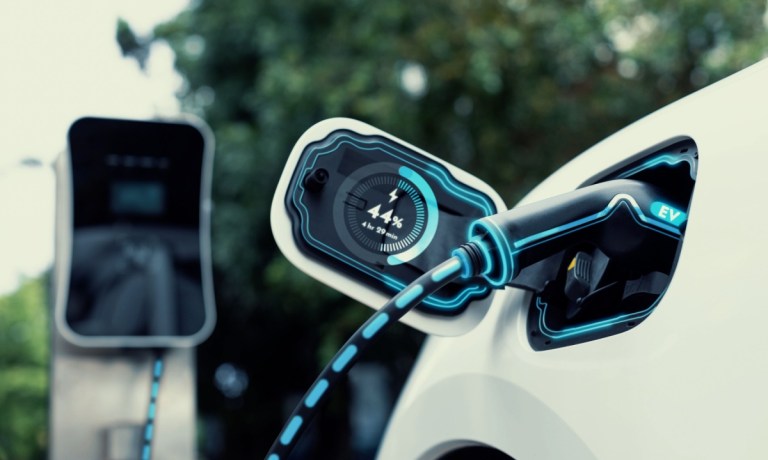
While the federal government last month allocated an additional $521 million for electric vehicle (EV) charging infrastructure, challenges persist in scaling EV production to meet market expectations.
In July Ford shifted its strategy for the Oakville Assembly plant in Canada, pivoting from its original plan to produce EVs to instead manufacture larger gasoline-powered versions of its popular F-Series pickup trucks. This delay is due to slower-than-expected EV demand. Despite the adjustment, Ford remains committed to EVs but has not announced alternative sites for future EV production.
Ford led traditional automakers with a 61% increase in EV sales year over year, reaching 23,957 units. This surge contributed to the company’s overall sales growth and cemented its position as the second-largest EV seller in the U.S., surpassing General Motors.
This latest federal funding is part of the $7.5 billion program created as part of the 2022 Inflation Reduction Act, which aims to build out fast chargers along interstate highways as well as bringing charging infrastructure to underserved communities.
In June 2023 Tesla secured a $3 billion boost following agreements with General Motors and Ford to adopt Tesla’s North American Charging Standard (NACS) for their EVs. This deal highlights Tesla’s edge, given that its network is more extensive and considered more reliable compared to the competing combined charging system (CCS).
Tesla’s network serves as the primary EV network in North America, covering about 70% of the EV market. Meanwhile,, CCS, American companies are also ramping up their EV charging capabilities. Walmart revealed in April plans to expand its fast-charging network across thousands of Walmart and Sam’s Club locations, increasing the total to nearly 1,300 stations. Similarly, 7-Eleven announced in March its intention to build one of the largest retail EV fast-charging networks, adding stations across its 7-Eleven, Speedway, and Stripes locations.
Despite some reports of a slow rollout of EV chargers nationally, in an interview with PYMNTS a spokesman for the U.S. Department of Energy said “We are on track to achieve the president’s goals years early. President Biden set a goal to build a network of 500,000 publicly available EV chargers to support the adoption of EVs and the development of a U.S. supply chain, creating good-paying jobs in manufacturing, installation, operations and maintenance in all pockets of the country.”
As of Aug. 27, according to the spokesperson, the U.S. had more than 192,500 EV chargers and 71,937 stations publicly available.
“Nearly 1,000 new public chargers are turned on every week, thanks to a combination of direct federal funding, federal tax incentives, state and local funding, and private investment,” the spokesperson said. “We expect to see hundreds of federally funded chargers operational this year, thousands next year, and hundreds of thousands of chargers by the end of the decade.”
For new high-power stations benefiting from federal funding from the National Electric Vehicle Infrastructure Formula Program (NEVI), “we are right where we expected to be.”
The Bipartisan Infrastructure Law passed in late 2021, and states began planning their EV charging infrastructure deployment in mid-2022, the spokesperson noted.
“We released minimum standards for federally funded chargers in early 2023,” the spokesperson explained. “After laying the groundwork to set up the NEVI and Charging and Fueling Infrastructure (CFI) programs, states and localities are now in the driver’s seat and all states are moving forward on implementing their federal EV charging funding. We are seeing a ramp up of infrastructure from federal dollars as the federal government passes money to state governments and state governments pass money to local governments and the private sector.”
For high-speed chargers along highway corridors, it takes 12 to 18 months, on average, to build, commission and energize a station, the spokesperson noted. Federal funding will help speed up the process.
“The growing number of chargers shows progress, but the true measure of success is the convenience and reliability of the network, along with the coverage and capacity of stations to ensure every EV driver gets the charge they need when they need it,” the spokesperson said. “The NEVI and CFI programs are designed to fill in gaps unmet by private investment and ensure reliable coverage along travel corridors and within communities so that rural and urban residents alike can have the choice to drive electric. We are closing gaps fast.”
When Biden took office, only 38% of the most heavily trafficked corridors had fast chargers at least every 50 miles, the spokesperson explained. Now, families can travel 57% of the most heavily trafficked corridors and expect a fast charger at least every 50 miles. By the end of next year, the spokesperson expects 70% of those corridors to be covered.
Currently, 80% of charging happens at home. For the other 20%, according to the spokesperson, “We are building a robust network of Level 2 charging close to home and at key destinations. For longer trips, this means making sure a network of fast charging is available along highway corridors.”
In the past year EV sales have slowed amid concerns among consumers about recharging as investors wait patiently to see profits.
The Federal Highway Administration released final standards for EV charging infrastructure funded by the NEVI program. These standards aim to create a nationwide, reliable network, support U.S. leadership in EV adoption, and generate skilled jobs by ensuring transparency and equity in the charging infrastructure.